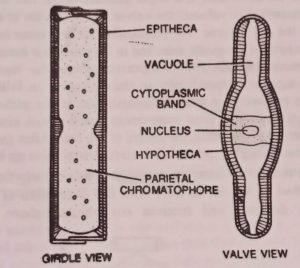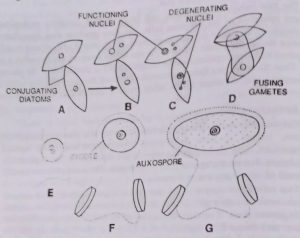Q. 3. Describe in brief about Navicula.
Ans.3. Navicula, a freshwater diatom, is cosmopolitan and uniquitous in distribution, found in ponds, lakes, etc. However, a few species occur in terrestrial habitats. The species of Navicula are very important as primary producers in the food web of aquatic ecosystems. The most common species of the genus occurring in India is N. halophila.
Thallus Structure
The plant body is unicellular with isobilateral symmetry. The cells usually occur in isolated form. The cell wall (frustule) consists of two overlapping halves, the upper half is said to be epitheca and the lower half hypotheca. Each theca is further divided into two parts: the main surface called valve and the incurved margins, known as connecting band. The two connecting bands of the two thecas are fitted together. The connecting band of the epitheca overlaps that of the hypotheca and the two bands remain united in the overlapping region (called girdle) by a cementing organic substance present between them.
A cell can be seen from two different aspects, the valve view and the girdle view. In valve view the cell appears boat-shaped and in girdle view more or less rectangular. The cell is several times longer than its breadth.

The cell wall is made up of crystalline silica and an organic component of unknown nature. In N. pelliculosa, the wall consists of a silica layer with an outer coating of organic material called organic skin. There is a longitudinal slit known as raphe. The raphe is interrupted in the middle by a central nodule formed by the internal thickening of the valve. Each pole of the valve contains a polar nodule, formed in the same manner as the central nodule.
The valve markings consist of fine pores bridged from the inside by sieve membranes also containing numerous fine pores. The raphe situated in the central rib is called apical rib. The rows of pores situated on the lateral sides of the apical rib and separated one from the other by solid silica ribs are known as transapical ribs. The pores within a row are separated by siliceous connections which link the adjacent transapical ribs.
The protoplast is surrounded by a thin plasma membrane, which lies close to the inner face of the cell wall. There are two brownish yellow chromatophores, adpressed to the girdle side in the resting cell. The nucleus is situated in the centre of a dense bridge of cytoplasm which connects the two chromatophores. The cytoplasm contains mitochondria, golgi bodies and endoplasmic reticulum. The reserve food material is in the form of fatty oils volutin globules.
Reproduction
Navicula reproduces vegetatively and by the formation of auxospores.
[I] Vegetative reproduction
There is rapid multiplication by successive divisions, which usually occur in the evening. First, one nucleus divides into two and then cytoplasm by an in-growing cleavage furrow.
Prior to cell division there is a slight increase in the size of the nucleus. The cell also increases in volume, the valves loosen a little to accommodate the increase in the cell volume. The nucleus, which is present in the centre of the cell, moves toward the girdle side, and in the process it loses its spherical outline and becomes somewhat compressed.
Now the nucleus divides mitotically in a plane perpendicular to the valves. It is followed by the division of the protoplast in two by invagination of the plasmalemma. In girdle view cytokinesis is seen commencing as a small cleavage which progresses centripetally towards the centre of the cell. After the completion of cytokinesis each daughter protoplast secretes a new valve on its inner side.
During the nuclear division chromatophores move away from the girdle and are adpressed to valves, as such with the completion of cytoplasmic cleavage each daughter cell receives one chromatophore. The single chromatophore divides transversely to form two chromatophores which take their usual position on the girdle side.

The two valves of the parent cell (each with a daughter protoplast) because epithecas of the daughter cells. But they produce new hypotheca. The daughter cell which retains the epitheca of the parent cell, attains nearly the same size as the parent cell. But the one which receives the hypotheca of the parent cell (now epitheca of the daughter cell) is smaller than the parent cell. Thus, there are two lines of descendants in cell division, one line retains the original size, whereas in the other there is diminution in size in the successive generations.
[II] Auxospore formation
The diatom, after reaching a certain minimum size due to repeated cell division, begins to form auxospores. Auxospores are infact special rejuvenescent cells, formed as a compensatory measure for the vegetatively reproducing diatom in regaining its normal size. The auxospores are usually the result of the sexual process in Navicula. (BSc 1st Year Botany Bacillariophyta Diatom Sample Model Practice Question Answer Papers)
Two cells come very close to each other, adhere by their valve surfaces or occasionally by their girdle faces and then get enveloped within a common mucilagenous mass. The diploid nucleus of each cell undergoes reduction division and forms four haploid nuclei.
Of these, two degenerate and two remain functional. The functional nuclei ultimately metamorphose into two amoeboid gametes. The two gametes show some amoeboid movements inside the halves and then round up. The valves of the mother cell are pushed apart at this stage and the two gametes of each pairing cell become free within their respective valves. A single chromatophore is present in each gamete.
The two gametes formed in one cell move towards the gametes of the other cell, and when they come in contact they fuse in pairs. The two zygotes lie in the cell where pairing of gametes took place. The two gametes which are more active and show movements, may be considered as physiologically male, while the other two, which are more or less stationary, may be regarded as physiologically female. (BSc 1st Year Botany Bacillariophyta Diatom Sample Model Practice Question Answer Papers)
Hence, both the gametes formed in a cell are either male or female.
The fusion of the two pairs of gametes is not simultaneous. First one of the male gametes moves towards the female gamete that is directly opposite to it and fuses with it and then the second male gamete follows that and fuses with the second female gamete.
Gamete formation invariably takes place late in the evening and actual fusion occurs soon after night-fall.
The zygotic is large and irregular to begin with, but later it contracts and becomes spherical. It secretes a wall round itself and is now known as auxospore.

The whole process of auxospore formation from the commencement of pairing of cells to the formation of new cells, takes about 24 hours.
Generation of Zygote
The zygote germinates after a resting period of few hours. In the germinating zygote the two chromatophores and the two gametic nuclei from two pairing gametes are still lying distinctly without fusing. Then, the protoplast of the zygote elongates considerably and the fusion of the two gametic nuclei occurs.
After the fusion of the gametic nuclei, new valves are secreted. The new cells always lie parallel to the old mother cell valves and are twice as long as the mother cell valves. The new cells after some time began to divide vegetatively and this marks the beginning of a new generation.
The four discarded valves of the two mother cells are often seen attached to the newly formed frustules. (BSc 1st Year Botany Bacillariophyta Diatom Sample Model Practice Question Answer Papers)
BSc 1st Year Botany Bacillariophyta Diatom Sample Model Practice Question Answer Papers
BSc 1st Year Botany Bacillariophyta Diatom Sample Model Practice Question Answer Papers
BSc 1st Year Sample Model Practice Mock Test Question Answer Papers